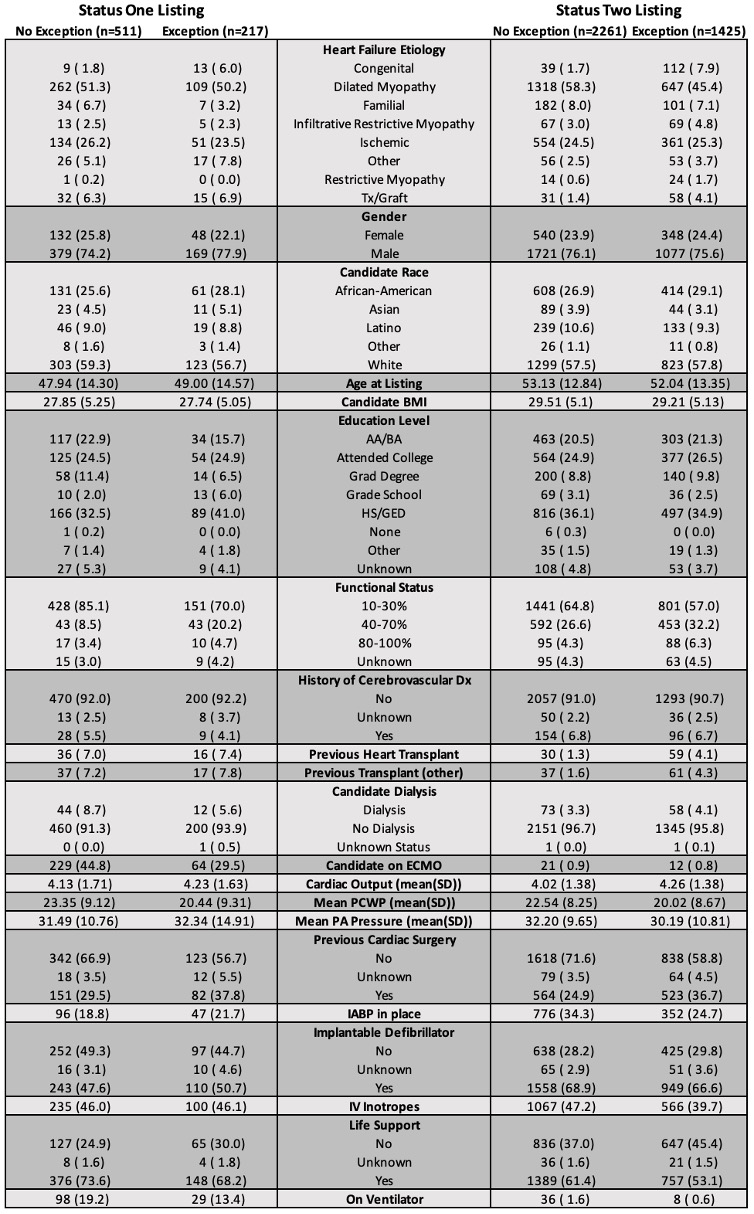Status Exception Use in the New Seven-Tiered Heart Allocation System
1Cardiology, University of Chicago, Chicago, IL, 2Pulmonary/Critical Care, University of Chicago, Chicago, IL, 3Cardiac Surgery, University of Chicago, Chicago, IL
Meeting: 2022 American Transplant Congress
Abstract number: 1117
Keywords: Allocation, Heart/lung transplantation, Waiting lists
Topic: Clinical Science » Heart » 63 - Heart and VADs: All Topics
Session Information
Session Time: 7:00pm-8:00pm
 Presentation Time: 7:00pm-8:00pm
Presentation Time: 7:00pm-8:00pm
Location: Hynes Halls C & D
*Purpose: The revised seven-tiered US heart allocation policy aimed to improve risk stratification to lower exception status use. However, recent literature has demonstrated that exceptions have since increased. The characteristics of patients listed as Status One and Status Two exceptions are unknown.
*Methods: This retrospective analysis of the Scientific Registry of Transplant Candidates (SRTR) included adults listed as Status One or Two after the new heart allocation system in 2018. Multivariable logistic regression determined the association of exception status with baseline characteristics including race, heart failure etiology, comorbidities, hemodynamic parameters, and inotropic and mechanical support.
*Results: 9,418 patients have been listed for heart transplant since the new policy implementation. 728 were designated as Status One with 217 (29.8%) utilizing an Exception; 3,686 as Status Two with 1425 (38.7%) utilizing an Exception. In comparison to White patients, African-American race was associated with Status Two exception use (OR 1.28, 95%CI 1.08-1.52, p<0.05). In comparison to patients with an ischemic etiology, congenital heart disease (CHD) (OR 3.46, 95%CI 2.21-5.54, p<0.05), infiltrative cardiomyopathy (CMP) (OR 2.08, 1.40-3.10, p<0.05), and restrictive CMP (OR 3.27, 95%CI 1.63-6.83, p<0.05) were all associated with Status Two exception use, as were higher cardiac output (OR 1.09, 95%CI 1.03-1.15, p<0.05) and lower pulmonary capillary wedge pressure (OR 0.97, 95%CI 0.97-0.98). Patients with familial CMP (2.00, 95%CI 1.43-2.78, p<0.05) and infiltrative CMP (5.52, 95%CI 3.75-8.11, p<0.05) were more likely to be African-American.
*Conclusions: Status exceptions in the new policy can lead to inequalities in organ allocation. CHD and infiltrative CMP may not meet typical hemodynamic criteria for transplant listing, leading to increased exception status use. Patients with familial and infiltrative CMP were more likely to be African-American, which may lead to inequalities in the new allocation system.
To cite this abstract in AMA style:
Plana A, Kanelidis A, Parker WF, Jeevanandam V, Salerno C, Smith B, Kalantari S, Pinney S, Grinstein J. Status Exception Use in the New Seven-Tiered Heart Allocation System [abstract]. Am J Transplant. 2022; 22 (suppl 3). https://atcmeetingabstracts.com/abstract/status-exception-use-in-the-new-seven-tiered-heart-allocation-system/. Accessed December 14, 2025.« Back to 2022 American Transplant Congress

